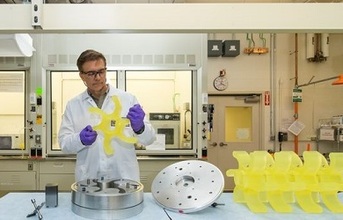
Lanxess data specialists and process experts used the Citrine Platform for artificial intelligence to add further data points to the company's formulation database.
Lanxess is broadening its use of artificial intelligence (AI) in product development. The specialty chemicals company has launched a project aimed at expanding its range of prepolymers. The goal is to offer customers tailor-made polyurethane systems with even shorter lead times, including for entirely new applications with different requirements. The Urethane Systems business unit is using the potential of AI and has brought materials AI company Citrine Informatics on board as a project partner.
In an initial project phase, Lanxess enlarged its database of prepolymer-based formulations. Lanxess data specialists and process experts used the Citrine Platform for artificial intelligence to add further data points to the company's formulation database. This involved linking existing empirical measurement data with the knowledge of the process experts and a chemistry-aware algorithm to calculate additional measurement values. This meant that only a few real-life measurements were required to verify the figures determined with AI.
In a next step, data and process experts at Lanxess will check how reliably optimal formulations can be predicted with the aid of AI to meet customer-specific requirements for product characteristics. "If the next tests are successful, we will be able to fulfill customer requests even more quickly and effectively. Our existing knowledge of formulations shall be enhanced by AI-assisted formulation design - in other words, systems that are not yet part of our portfolio but for which artificial intelligence will enable us to know instantly whether we can manufacture them and how," says Markus Eckert, head of the Urethane Systems business unit at Lanxess.
So far, chemists have largely had to rely on their specialist expertise and years of experience when researching new formulations with defined product characteristics such as hardness, tensile strength and viscosity. AI is expected to become an important tool to help them broaden their knowledge and significantly reduce the amount of tests required.
Lanxess already has some experience in using AI. In a pilot project with Citrine Informatics, the specialty chemicals company is using AI to optimize glass fibers as a way of further enhancing the properties of Lanxess high-performance plastics. It is anticipated that AI will cut development times for the necessary formulations by more than half. Customers will receive even better, tailor-made products within shorter time frames.
For Jörg Hellwig, Head of the Lanxess Digitalization Initiative, the partnership between Citrine and the Lanxess Urethane Systems business unit demonstrates the growing role of digitalization in product development. "Most employees who are already using artificial intelligence cannot imagine ever going back to the old methods of working. The use of digital technologies is increasingly becoming standard procedure at Lanxess," says Hellwig.
Lanxess launched its digitalization initiative in 2017 and established a dedicated team to handle it. It is headed by Chief Digital Officer Jörg Hellwig, who reports directly to Matthias Zachert, Chairman of the Board of Management at Lanxess AG. The initiative's core fields of action are to develop digital business models, introduce new technologies along the value chain, develop and utilize big data and foster digital expertise among employees.
Citrine Informatics is the industry leader in the use of data and AI to accelerate the development of materials and chemicals. Citrine has been recognized for technology innovation by the World Economic Forum as a Tech Pioneer, and collaborates with some of the best universities in the world, including Carnegie Mellon University in Pittsburgh, Pennsylvania, and the University of California, Berkeley.
END



























